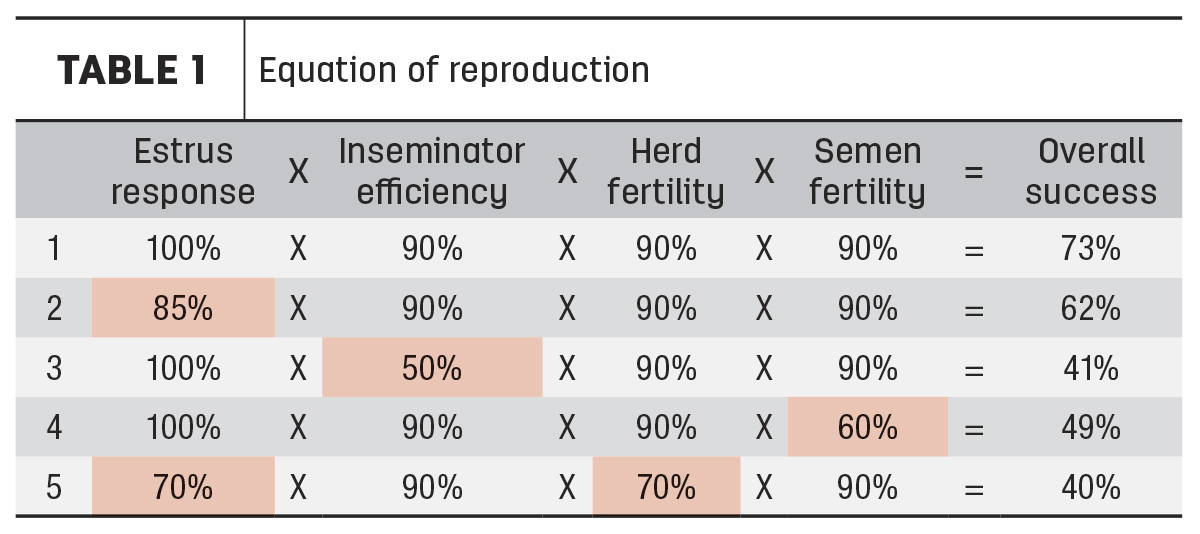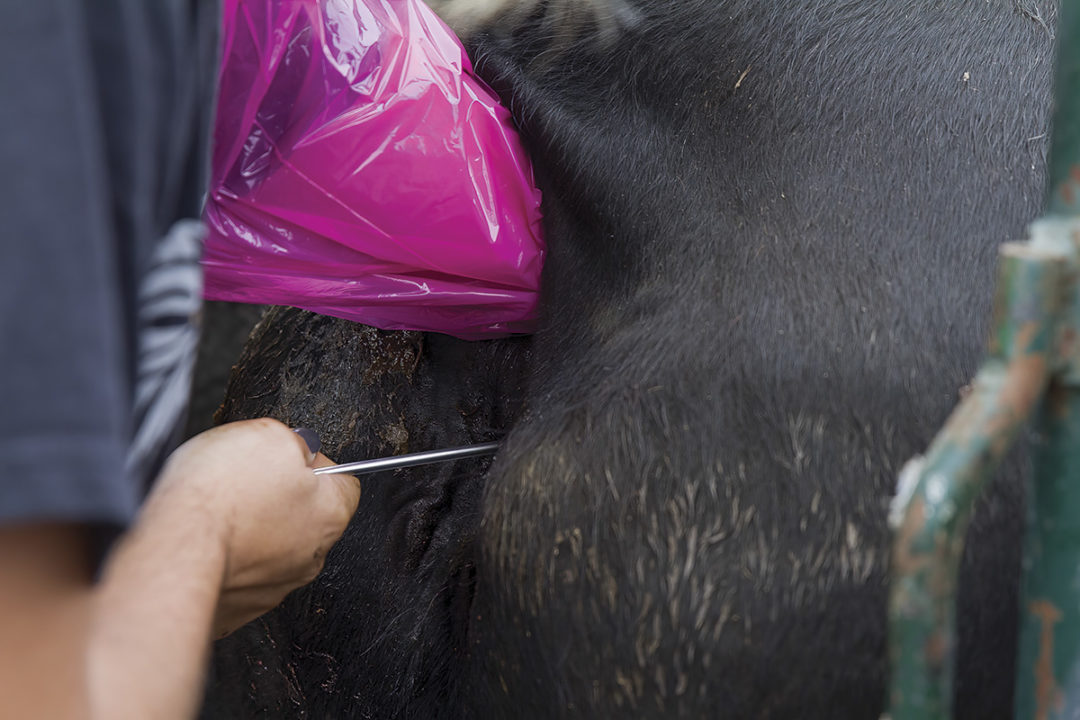As with everything in the beef industry, there is no magical potion or protocol that will guarantee achieving maximum success with an A.I. program in all management scenarios. One of the best recipes for success with an A.I. program is keeping a keen eye on all aspects of herd management, nutrition, vaccinations and administration and implementation of synchronization protocols.
The reproductive success of an A.I. program is the result of a culmination of several aspects that are best described in an “equation of reproduction” in Table 1.
In the above equation, the overall success of the A.I. program, or even bull natural service, is dependent on the estrus response (number of heifers or cows that come into heat), the efficiency of the inseminator (A.I. technician or bull), fertility of the herd and semen fertility (A.I. straw of semen or natural service bull). As you can see in Example 1 in the table, when the herd is well managed and all females are inseminated, we have the optimal potential to get a strong overall success rate with an A.I. program.

However, when we begin to see reductions in certain areas, such as in Example 4 where semen fertility is reduced, this change drastically affects the overall performance of an A.I. program, or even natural service bulls. Furthermore, when we have challenges in multiple areas, as in Example 5, we have below-optimal results with an A.I. program. Now that we can see how challenges and reductions in certain aspects of the equation of reproduction reduce overall success, let’s dig in to some of the factors to help ensure we maintain these influencing aspects to their maximum potential.
When considering starting an A.I. program, one of the first things I observe is existing cattle-handling facilities. With most estrus synchronization and A.I. programs, cattle will need to be handled from two to four times to implement the entire program. It is imperative to maintain cattle gathering and handling facilities that allow you to work cattle calmly and efficiently. If current facilities don’t allow this, take a look at portable corrals, alleyways, chutes or A.I. barns to help improve the comfort and efficiency of the work.
Before considering an A.I. program, analyze the current reproductive successes and failures in your heifers and cows. At what rate are your females getting pregnant during a defined breeding season (45 to 60 days)? An ideal pregnancy rate should be 85% or higher within a breeding season, as long as your A.I. program and/or bulls are doing their part.
Next, consider the factors that may be leading to a lower success rate. Determine whether your heifers are being developed to reach 55% to 65% of their mature bodyweight, then consider the body condition score (BCS) of your cows. Are they on a consistent nutrition program that allows them to maintain or gain bodyweight going into the breeding season? Females in a good (5 to 6) BCS consistently perform better in an A.I. program than lower-BCS females. Be sure to continuously monitor weight and BCS throughout heifer development and in the cow herd so you can make gradual nutritional changes as needed to ensure they are in the correct weight/condition at the time of breeding. Also, make sure you have an adequate mineral available for consumption to meet the females’ need for that area and time of year. Work with your local veterinarian to develop a vaccination program for your herd, and work with your veterinarian to implement that program in advance of the breeding season.
Returning to the equation of reproduction, the estrus response of your group of females can be altered using estrus synchronization programs. Some estrus synchronization programs that allow you to heat detect and inseminate the females based on estrus response (Example 2) may result in only inseminating 85% of the total group of females. Other estrus synchronization programs allow you to use a fixed-time A.I. of all females in the group (Example 1), which will give every female an opportunity to become pregnant. The currently recommended estrus synchronization programs work very effectively and allow producers to get a large portion of the herd pregnant on the first day of the breeding season.
One of the other contributors to the success of an A.I. program is inseminator efficiency. This refers to the ability of the person performing the A.I. procedure to consistently deposit the straw of semen in the correct place on every female. This is a skill that can be taught in a few days at an A.I. training session, or with supervision on-farm from an experienced A.I. technician. However, to become proficient at this skill, you must continue to practice and improve your skills regularly. This is not a skill that is developed over a few days. If you are planning to use an estrus synchronization program and A.I. all your cows at one time, make sure you have an experienced A.I. technician lined up who can handle the size of the group.
The final aspect of the equation of reproduction is semen fertility. All major A.I. companies have a high standard their semen must meet before being marketed. The semen straws that leave their facilities have passed numerous evaluations to be certain the quality meets those high standards. However, what happens to those straws of semen once they leave the initial A.I. company can affect the fertility of the semen. Follow all recommended semen-handling procedures to be sure every straw of semen has the maximum level of fertility to help your A.I. program be successful.
In the video below, author Dan Busch discusses best practices for starting an A.I. program in a presentation for the Beef Reproduction Task Force.







